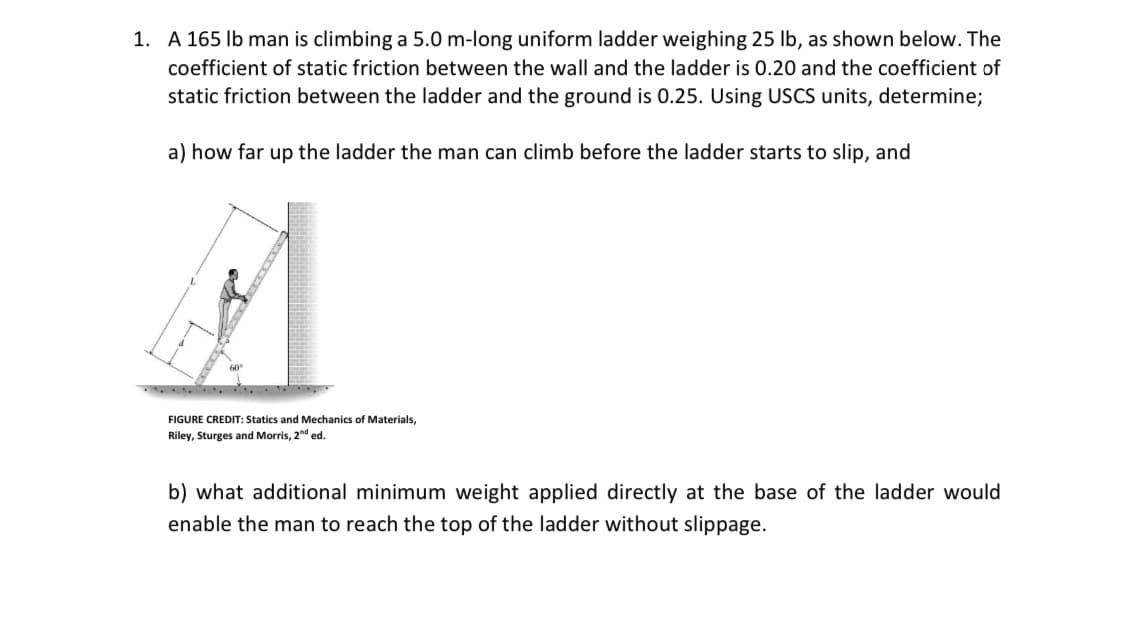1. A 165 lb man is climbing a 5.0 m-long uniform ladder weighing 25 lb, as shown below. The coefficient of static friction between the wall and the ladder is 0.20 and the coefficient of static friction between the ladder and the ground is 0.25. Using USCS units, determine; a) how far up the ladder the man can climb before the ladder starts to slip, and FIGURE CREDIT: Statics and Mechanics of Materials, Riley, Sturges and Morris, 2nd ed. b) what additional minimum weight applied directly at the base of the ladder would enable the man to reach the top of the ladder without slippage.
1. A 165 lb man is climbing a 5.0 m-long uniform ladder weighing 25 lb, as shown below. The coefficient of static friction between the wall and the ladder is 0.20 and the coefficient of static friction between the ladder and the ground is 0.25. Using USCS units, determine; a) how far up the ladder the man can climb before the ladder starts to slip, and FIGURE CREDIT: Statics and Mechanics of Materials, Riley, Sturges and Morris, 2nd ed. b) what additional minimum weight applied directly at the base of the ladder would enable the man to reach the top of the ladder without slippage.
Physics for Scientists and Engineers, Technology Update (No access codes included)
9th Edition
ISBN:9781305116399
Author:Raymond A. Serway, John W. Jewett
Publisher:Raymond A. Serway, John W. Jewett
Chapter12: Static Equilibrium And Elasticity
Section: Chapter Questions
Problem 12.23P: One end of a uniform 4.00-m-long rod of weight Fg is supported by a cable at an angle of = 37 with...
Related questions
Question

Transcribed Image Text:1. A 165 lb man is climbing a 5.0 m-long uniform ladder weighing 25 lb, as shown below. The
coefficient of static friction between the wall and the ladder is 0.20 and the coefficient of
static friction between the ladder and the ground is 0.25. Using USCS units, determine;
a) how far up the ladder the man can climb before the ladder starts to slip, and
60
FIGURE CREDIT: Statics and Mechanics Materials,
Riley, Sturges and Morris, 2nd ed.
b) what additional minimum weight applied directly at the base of the ladder would
enable the man to reach the top of the ladder without slippage.
Expert Solution
This question has been solved!
Explore an expertly crafted, step-by-step solution for a thorough understanding of key concepts.
This is a popular solution!
Trending now
This is a popular solution!
Step by step
Solved in 5 steps with 5 images

Knowledge Booster
Learn more about
Need a deep-dive on the concept behind this application? Look no further. Learn more about this topic, physics and related others by exploring similar questions and additional content below.Recommended textbooks for you

Physics for Scientists and Engineers, Technology …
Physics
ISBN:
9781305116399
Author:
Raymond A. Serway, John W. Jewett
Publisher:
Cengage Learning

Principles of Physics: A Calculus-Based Text
Physics
ISBN:
9781133104261
Author:
Raymond A. Serway, John W. Jewett
Publisher:
Cengage Learning

College Physics
Physics
ISBN:
9781938168000
Author:
Paul Peter Urone, Roger Hinrichs
Publisher:
OpenStax College

Physics for Scientists and Engineers, Technology …
Physics
ISBN:
9781305116399
Author:
Raymond A. Serway, John W. Jewett
Publisher:
Cengage Learning

Principles of Physics: A Calculus-Based Text
Physics
ISBN:
9781133104261
Author:
Raymond A. Serway, John W. Jewett
Publisher:
Cengage Learning

College Physics
Physics
ISBN:
9781938168000
Author:
Paul Peter Urone, Roger Hinrichs
Publisher:
OpenStax College

Physics for Scientists and Engineers: Foundations…
Physics
ISBN:
9781133939146
Author:
Katz, Debora M.
Publisher:
Cengage Learning